Public Pier — Freshwater — Fishing License Required
One day as I walking up the ramp that leads to the pier I was greeted by a powerful, baritone voice singing out “Welcome to the Cable Pier!” Turned out it was a large, African-American gentleman who was just a little frustrated from the loss of his sinkers and lures to the cable that runs parallel to the pier. I was already aware of the greedy lust shown by the underwater goblins at the pier but had always blamed the loss of tackle on the underwater ledge that’s located out from the pier. Maybe it’s due to one, maybe the other, maybe both? But no mistaking it, the pier had gained a new nickname — the Cable Pier. I guess that goes well with the old moniker — “Snag City.”
As for the Paul Robeson look alike and sound alike (do you know your history?), he was a non-stop talker with a million stories. He and his friendly young German shepherd kept me entertained which was a good thing since the fish, of any type, were missing and it would have been a long, hot, dull August day without his company. Such is fishing.
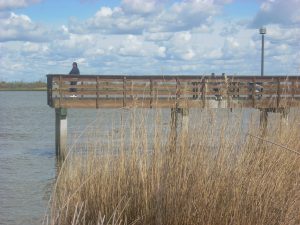
No matter the danger of losing gear, and the occasional “dead” day, this small pier has attracted a loyal group of regulars who like to fish for the large stripers and larger sturgeon in the area.
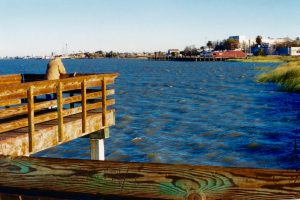
The Antioch Pier sits just a short distance up the shoreline from the Antioch Marina Pier
Environment. The 100-foot-long and 10-foot-wide pier was built in 1990 and sits in the San Joaquin River just opposite Kimball Island. The shoreline is typical delta-type vegetation with grass and a few wild orchids or iris. A two-acre park surrounds the Antioch Marina and nearby is a 690-acre wetland preserve.
Water depth at the pier varies with a roughly 6-foot average depth at the eastern end of the pier and nearly 20-foot depth at the western end. However, straight out from the pier sits “the ledge” that sees a drop in water depth to 40 feet and it’s reachable by a good, long cast. The deep water, just beyond this ledge, has yielded a lot of sturgeon including many of the large (over 60 inch) sturgeon, which with today’s regulations need to be returned to the water. But again, the ledge (and perhaps a cable) also catches a lot of tackle so come prepared with extra leaders and sinkers.
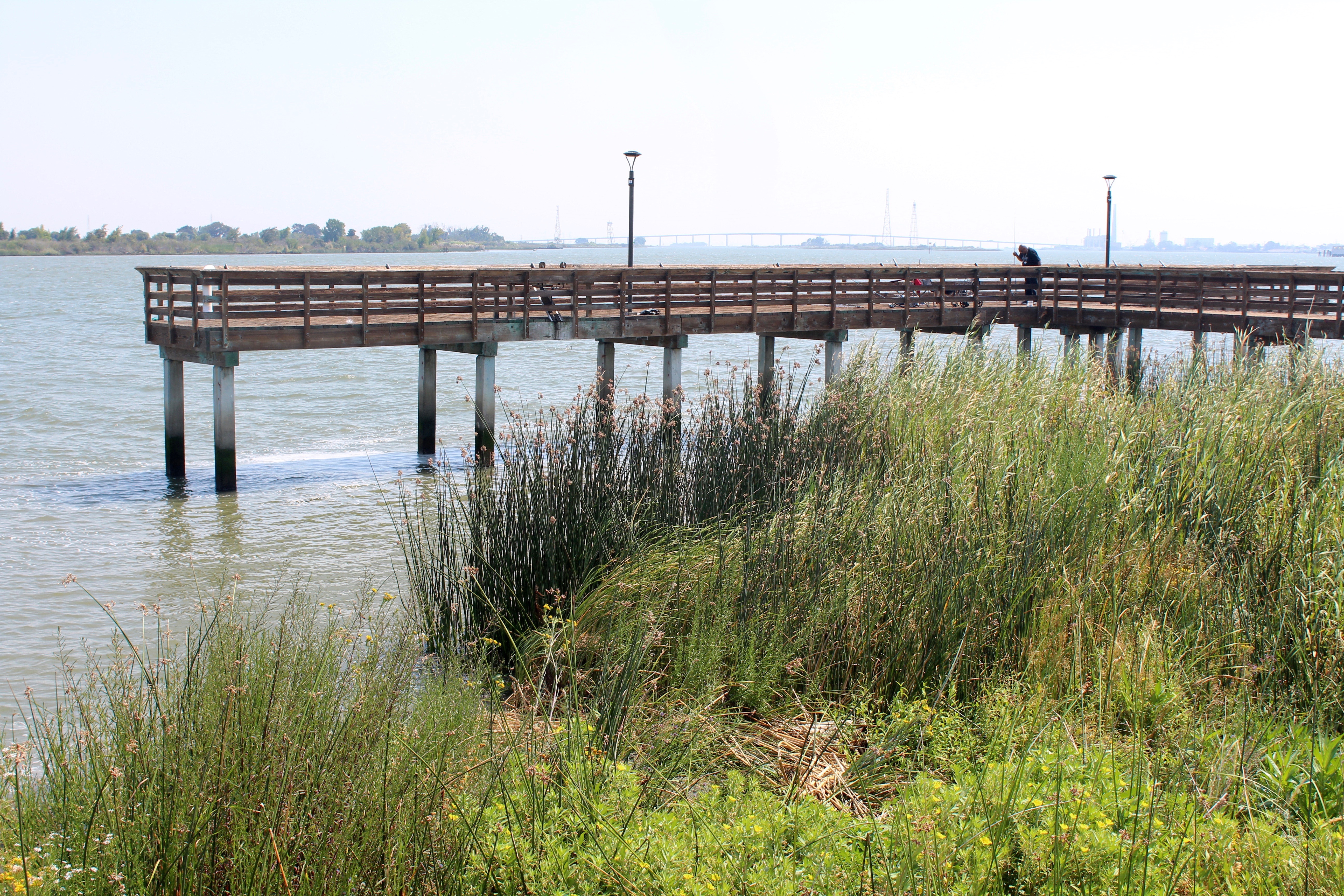
The current can be quite swift here and may demand a 4-6 ounce sinker (or more). There are a lot of rocks and obstructions in the water and this is certainly one reason why some anglers don’t like to fish from the pier. However, such a bottom can attract a lot of fish and such an area simply requires a little extra care by anglers. Both striped bass and sturgeon can be caught here but stripers are much more common.
In addition, a number of smaller species will be caught here—several different species of catfish (mainly white catfish, channel catfish and yellow bullhead), largemouth (black) bass, and some incidental species such as Sacramento Pikeminnow (aka Sacramento squawfish) and carp.
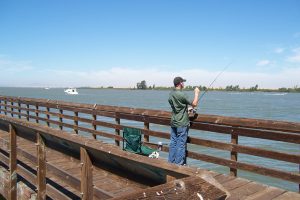
Fishing Tips. This has proven to be a good pier for sturgeon even though the pier itself is small compared to most piers. The diamondbacks are typically caught in the deep water, straight out from the pier, and the preferred baits include ghost shrimp, grass shrimp and blue mud shrimp. Use a medium weight rod and reel geared for the heavy current and again, be prepared to lose some tackle to the ledge that sits out from the pier.
Striped bass are the other main fish sought out by local anglers and chances are good for a striper, although probably not as good as at other local piers. Typical bait is cut anchovies, sardines or shad together with pile worms and grass shrimp. Because of the obstructions, and rarely crowded conditions, this is also a good pier to try artificials. Spoons, plugs, spinners and spinner-baits will work here and sometimes yield both striped bass and largemouth bass. Local favorites, include Rat-L-Traps (colored blue or chartreuse with a red belly), Fish Traps, Hair Raisers and Stump Jumpers. Spinnerbaits work best on the largemouth bass (although the waters of the nearby marina are much better for largemouth bass, bluegill and crappie). Artificials may also yield a few salmon or steelhead in the fall but they are few and far between. For smaller stripers simply use pile worms or cut shad.
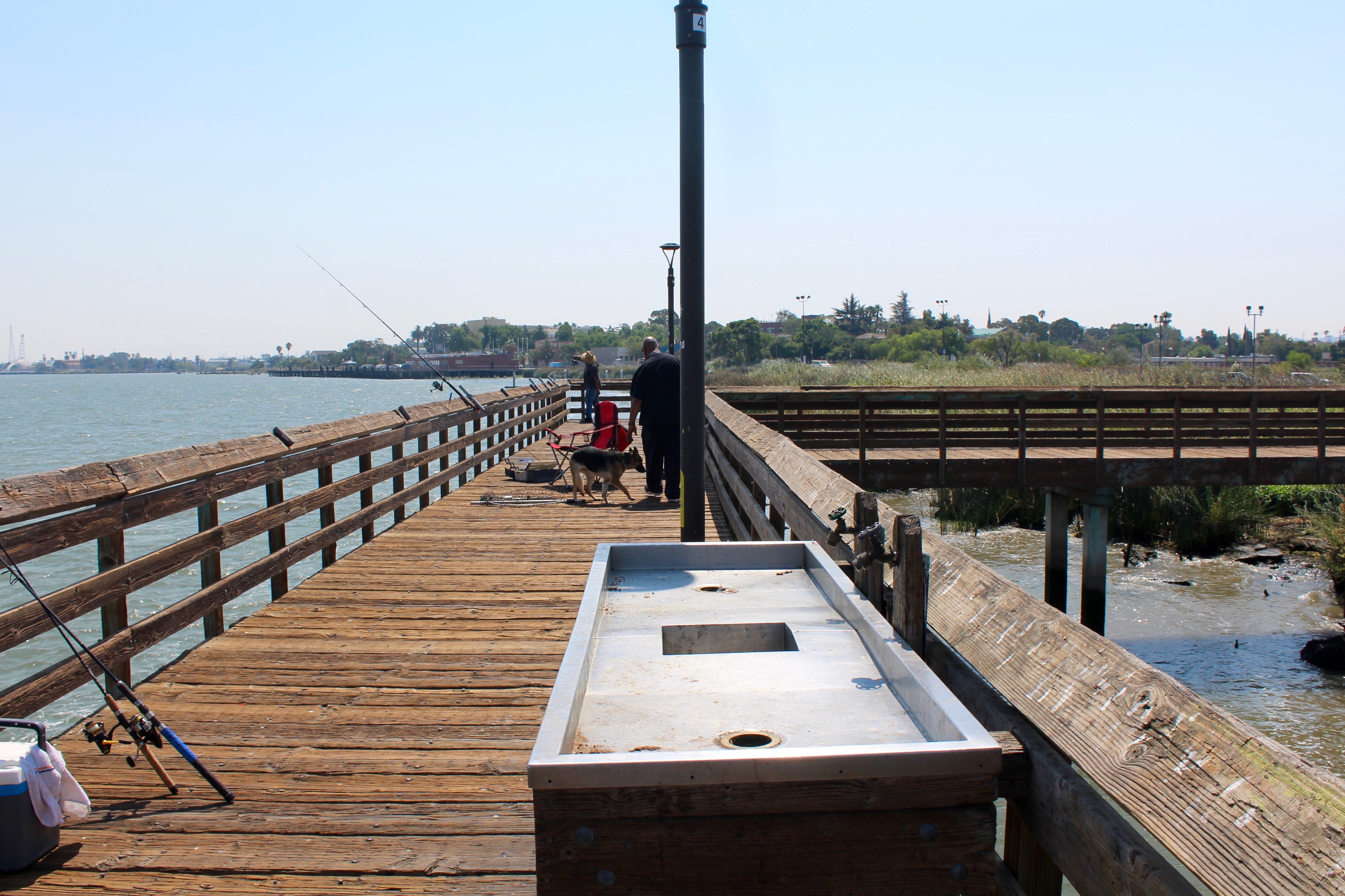
For catfish, and quite a few are taken at the pier, try cut anchovies, sardines, mackerel, clams, shad, grass shrimp or pile worms. Be sure to keep your bait near the bottom and best results seem to come from the shallower water areas rather than in the deeper waters straight out from the pier. Most of the local catfish are white catfish weighing 1/2 to 2 pounds, and anglers have told me of days when they caught upward of 20 pounds of catfish in just a few hours.
As mentioned, largemouth (black) bass are a possibility although their numbers are far fewer than striped bass. If seeking out those gamesters try live minnows or artificial lures near the inshore area. Prime fishing time seems to be in the late spring and I’ve been told of 4-5 bass in a couple hours of fishing (using artificial lures).
Most of the other species you will catch here are incidental to the main fish already mentioned but pikeminnows (squawfish) are common while carp and other species (such as black crappie) are a possibility. One anadromous species you may encounter, generally during the late winter to spring months is starry flounder on the bottom but they’re rarely common.
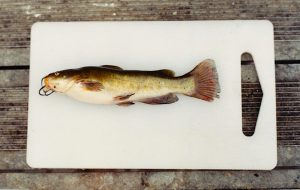
Yellow Bullhead Catfish
In the fall the pier can also yield a salmon or two but most anglers seeking salmon cast their lures from the dock that sits a short distance away from the left end of the pier.
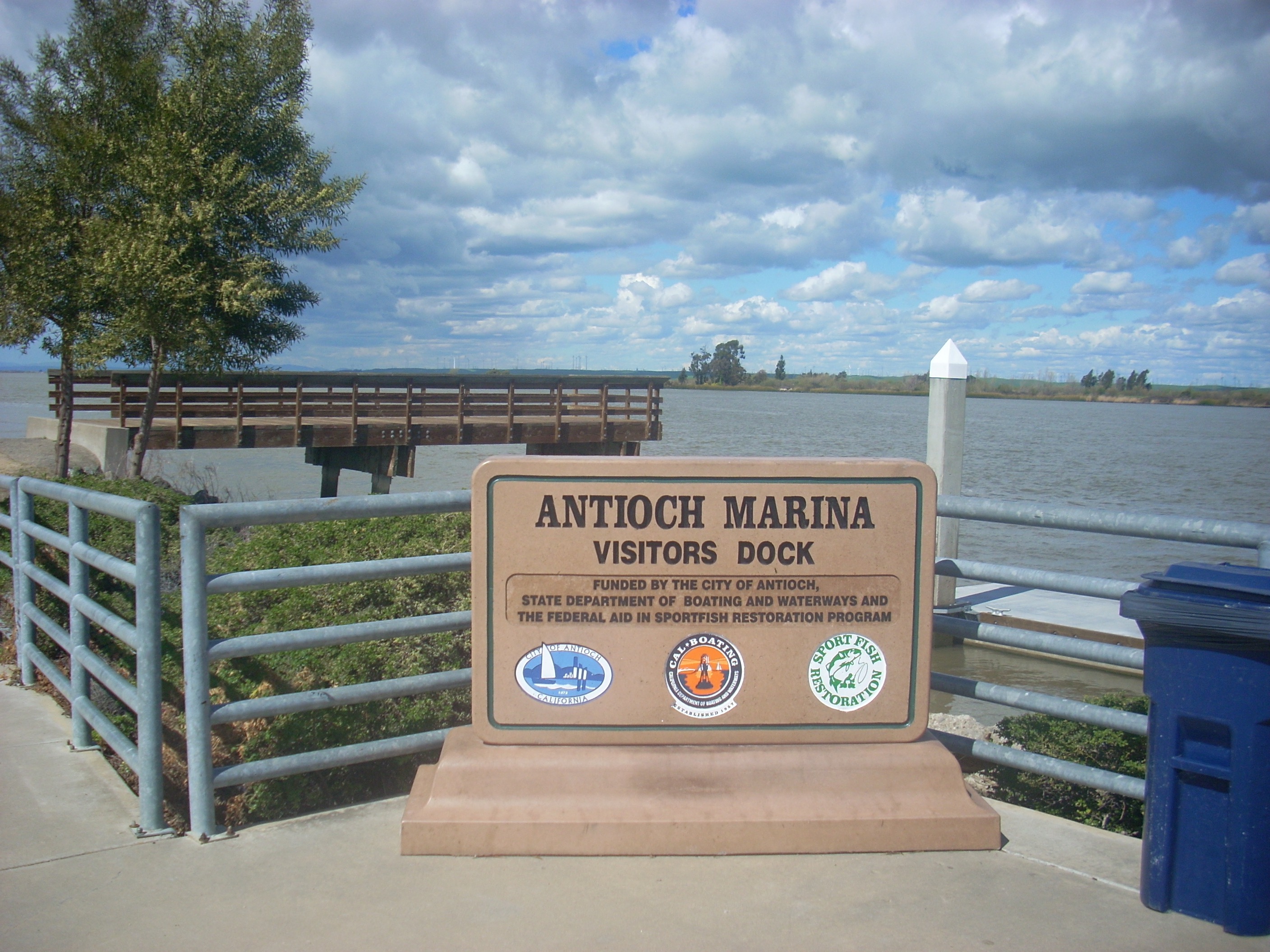
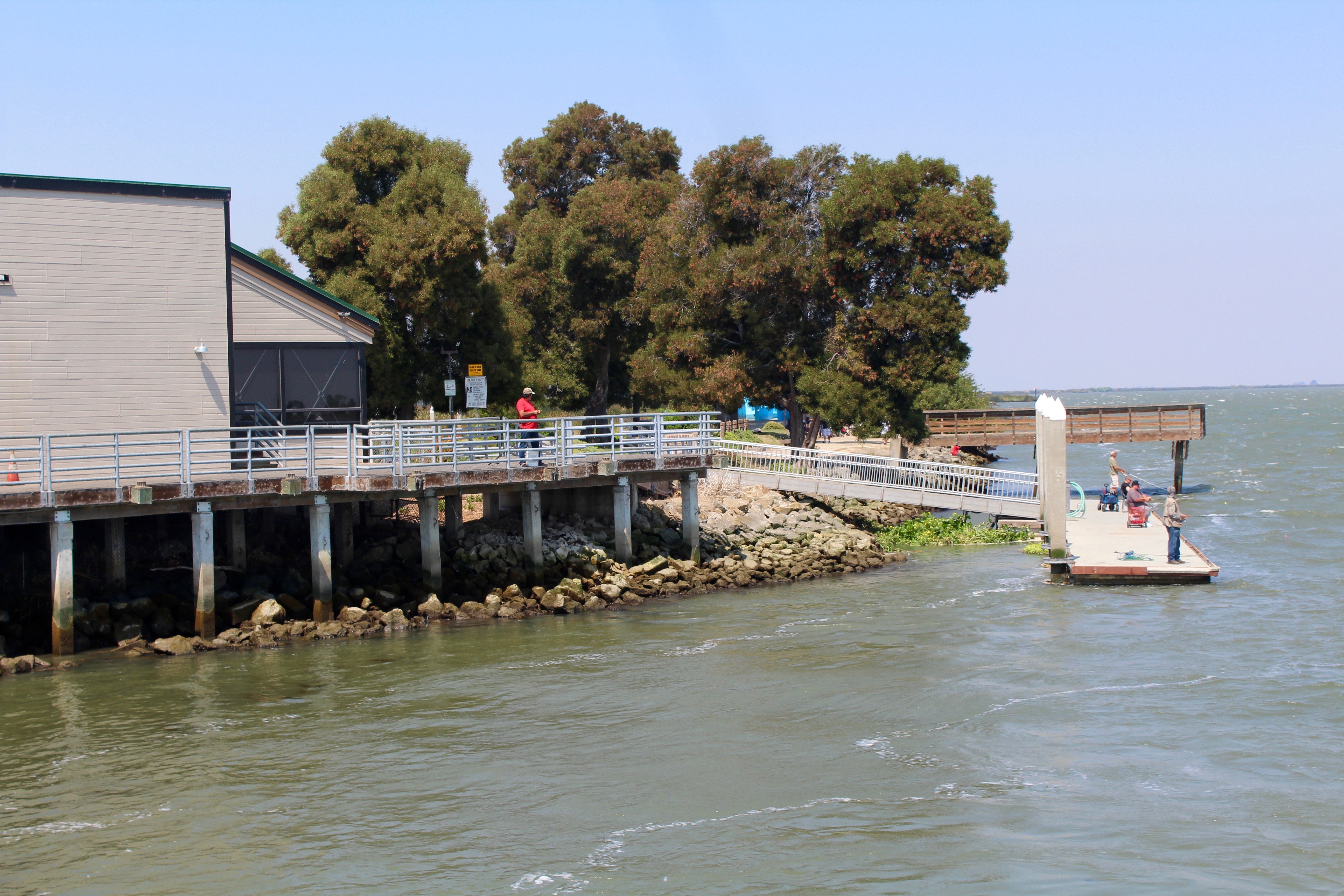
<*}}}}}}}}}>< — Spending the night at a pier is almost always an interesting experience and it was no different when I spent part of an all-night, pier-hopping trip here in May of 2001. The visit began with strong winds that died out after about half an hour. Thereafter it was fairly warm and allowed me to focus on the fishing (which was only fair) and the environment (which was fascinating). Amidst half-seen animals along the shoreline (which I never identified) were the nearly hour-and-a-half shrieks, hisses and sounds of animals fighting. Were two animals fighting over territory? Was one attacking the other for food (not likely given the prolonged nature of the sounds)? I never knew but it certainly highlighted the dual nature of these waters.
On one side of the river sits an exploding population and a heavily industrialized shoreline. It’s the busy Pittsburg-Antioch corridor and it would seem to jeopardize the thousands of acres of the Delta just east of Antioch. Luckily, much of the area across the water is state parkland or farmland not likely to be converted to suburbia. But anyone who studies the Delta knows the fragility of the area and know that the headlines that shout “collapse of the Delta” do not exaggerate.
That night though the harmony of nature took over and my focus was on the scene in front of me. First attracting my attention were the nocturnal animals out for a little action. Next was the really HUGE ship passing the pier as it headed down river from an inland port (either Stockton or Sacramento). Finally, ending the spell, was the freshwater otter that decided to spend its time paddling between the pier and the shoreline just before I called it a night. Oh, as for the fishing, one striper, one white catfish and two Sacramento squawfish (captured before those in charge changed the politically incorrect name squawfish into the more politically correct name pikeminnow). That’s all that I managed to catch in two and a half hours although all were of fairly good size. But, I had enjoyed the simple pleasures of nature so much that I didn’t mind the slow fishing. It was a life of Riley time and the normal daily concerns and fears for the Delta were mostly forgotten.
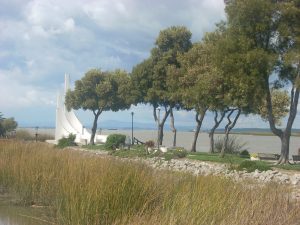
<*}}}}}}}}}>< — For years the restaurant located next to the pier was the Humphrey’s Restaurant and the pier acquired the nickname “Humphrey’s Pier.”
The restaurant was named after Humphrey, the humpback whale that wandered into San Francisco Bay back in October of 1985. Whales wandering through the Golden Gate aren’t that unusual, but this one just kept going. Up through San Pablo Bay, into the Carquinez Strait, past Suisun Bay and all the way to Shag Slough north of Rio Vista. Humphrey’s little jaunt had taken him nearly 70 miles inland. Once in the shallow slough he refused to leave, at least for five days. Concerned citizens finally assembled a flotilla and tried to drive Humphrey out by banging on pipes that had been lowered into the water. Their efforts to form a “sound net,” a Japanese technique known as “oikami,” was only partially successful. He did move but not too far. Scientists then rigged up underwater recordings of humpback whales feeding and were finally able to lure Humphrey back down to Angel Island (a distance of 50 miles in one day), and out into the Pacific.
Five years later, Humphrey showed up in San Francisco Bay once again. This time Humphrey became stuck on a mudflat just north of Sierra Point. He was finally pulled off the mud by a Coast Guard boat using a large cargo net. Soon after, the wayward Cetacean was once again ushered out of the bay amidst a cacophony of steel pipes and his favorite whale recordings. He soon was swimming in the mighty Pacific where he belonged. He was spotted one year later, in 1991, at the Farallon Islands, but seemed to have learned his geography lessons. He hasn’t been seen since but hopefully he’s still out there somewhere chasing female humpbacks and eating some jumbo squid.
As for the restaurant, it closed in 2012 after filing for bankruptcy. Eventually the city took over the site and finally it leased the site to a new group. The new restaurant, Smith’s Landing, was set to open in September 2018.
As a history note, Smith’s Landing was the original name given to the site by the Smith brothers in 1849. They later named the town itself Antioch.
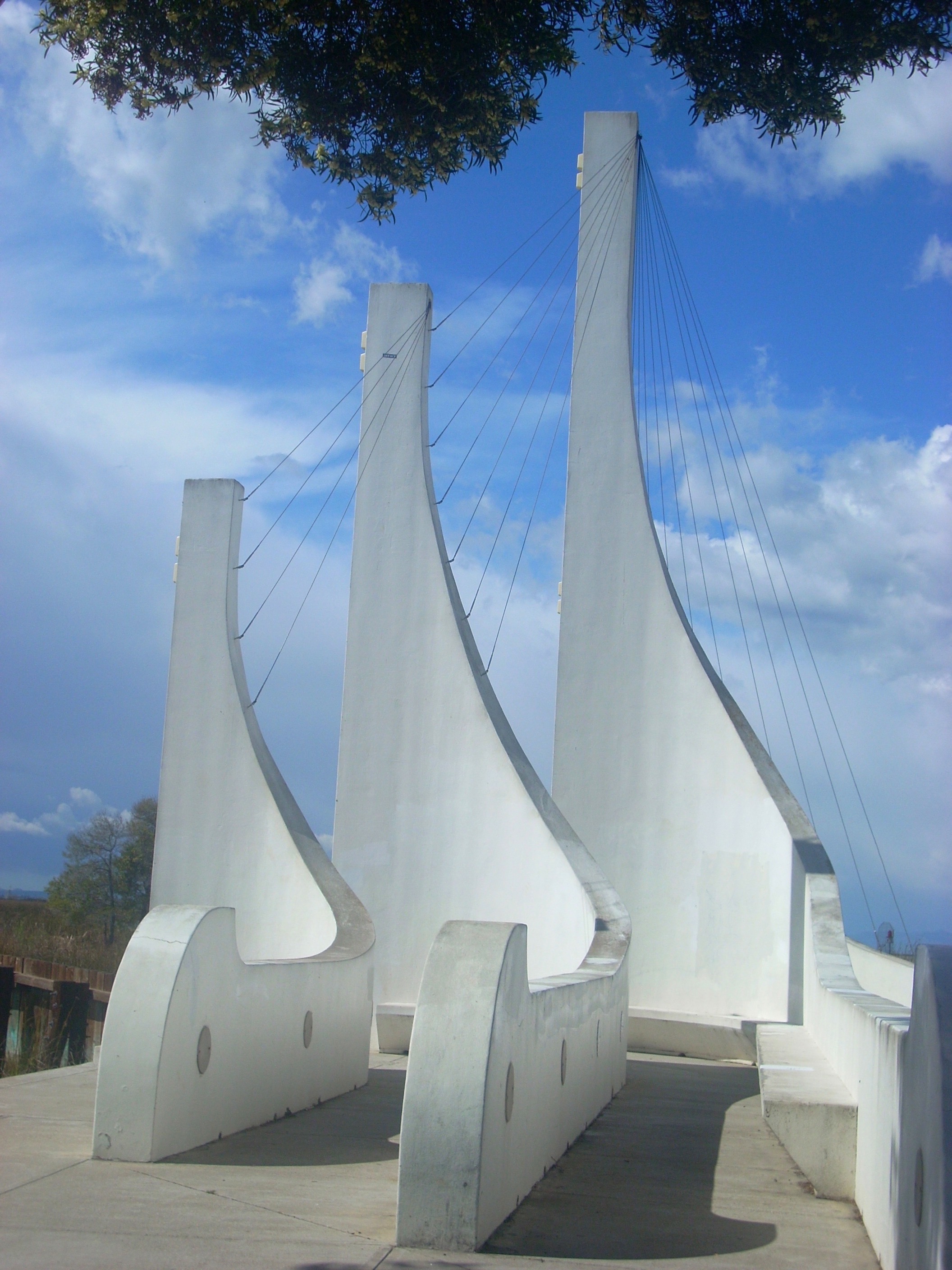
<*}}}}}}}}}>< —The following is an old post from the Fish Sniffer Magazine message board and offers yet another reason for the snags at the pier. Posted by sturgeon_general on April 23, 2009: Re: Humphrey’s Pier, anyone know if sturgeon are biting?
This is where I grew up fishing 40 + years ago. This is one of the deepest spots in the whole San Joaquin River; this is where they turn the big freighter ships around so they can head back to the ocean after unloading there cargo in Pittsburg and Antioch (Domtar, Dow Chemical, USS Possco and the Coke burning power plant). The reason you are getting snags is right where the marina and Humphreys restaurant sits. Many, many years ago this used to be Tillie Lewis Cannery where they canned all the tomatoes, peaches, apricots and etc. When they tore down all the pipes and machinery a lot of it missed or fell off the barges they were using to transport the scrap metal and now it resides on the bottom of the river in about 55 feet of water. So, when you cast your fishing pole your sinker rolls on the bottom till you snag on this debris. It doesn’t matter what size sinker you use (big or small) you end up with the same result a snag. The Dept. of Waterways and the DF & Game built a great fishing pier there but nobody ever uses it because you will lose twenty dollars worth of tackle every time. Just a few years ago the public pier by Riverview Lodge had the same problem so a local citizen Compy Compomizzo who’s now deceased and is famous for the program & quote; Get Hooked On Fishing And Not On Drugs; started raising money to rid the fishing pier of all the snags. To make a long story short it took many years but he raised $250,000.00 dollars to hire divers, a clam shell bucket dredge, and 2 barges to hold the debris. It ended up filling 8 barges with motorcycles, bicycles and every type of garbage from the 1870’s to the present day. And now the public fishing pier is snag free and a major attraction to many anglers. That is what needs to be done at the fishing pier at Humphreys which is 200 yards away from the new snag free pier. It’s sad that the state would spend a quarter of a million dollars on a state of the art fishing pier that nobody uses because of snags and debris, it even has a park and bbq pits and tables. The Sturgeon General.
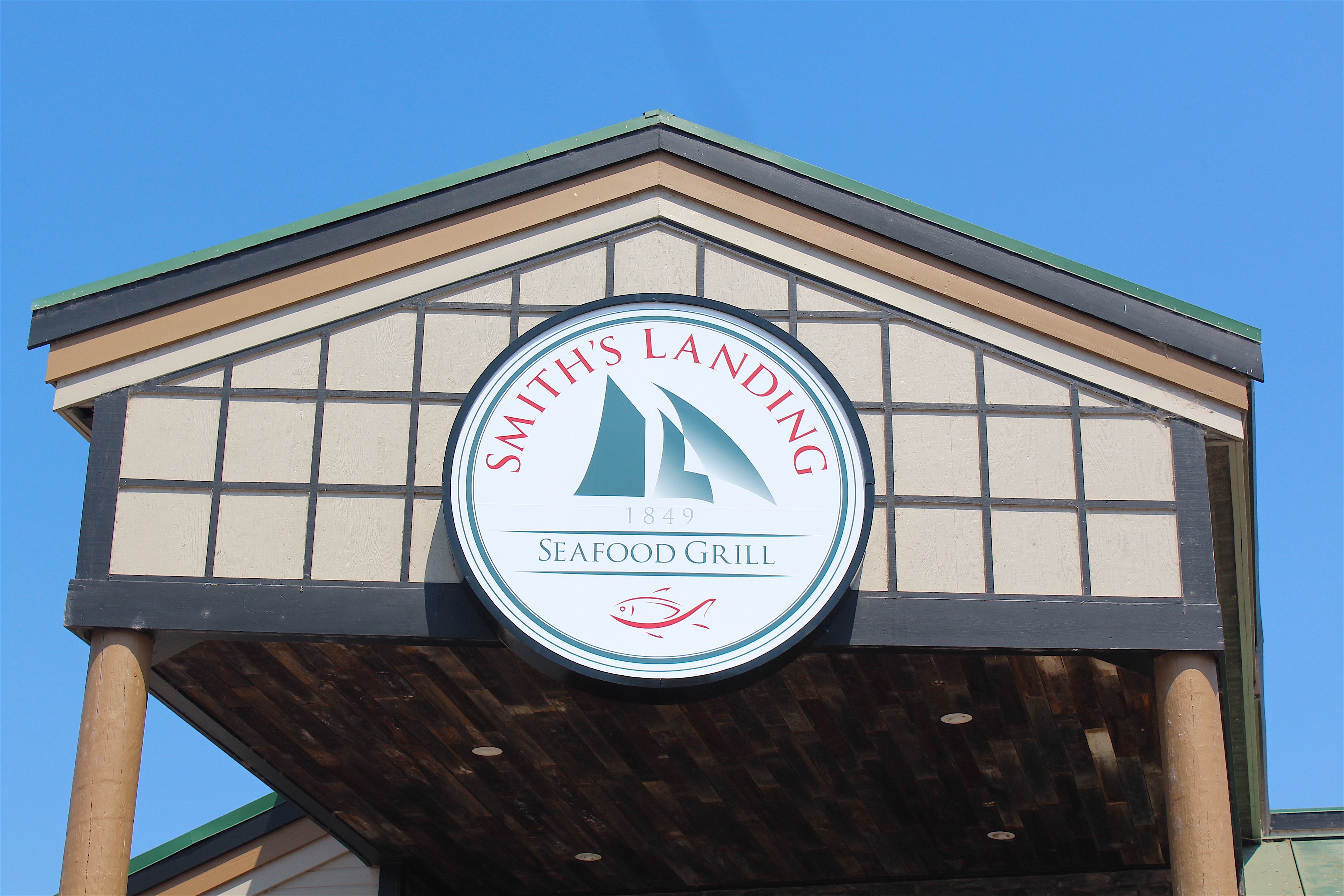
<*}}}}}}}}}>< — It may be a little-known retreat but not to fishermen.
Antioch Marina is a little-known retreat
Antioch — It may be one of the best kept secrets in town—and some of its fans prefer to keep it that way. The Antioch Marina offers a quiet, idyllic location near downtown at the foot of L Street that attracts anglers, boaters, joggers, and those who just want to hang out at the Barbara Price Marina Park with a view of the San Joaquin River.
“It’s a place to relax and think awhile, just clear the mind,” said Ben Whitener, a Bethel Island firefighter, during a visit to the park with a friend. Whitener said he comes here about once a month to walk around, contemplate the river flowing by, feel the breeze’s kiss or just people watch. “That’s another good part of it,” he said. “There’s not a lot (of people). At the same time, there are people so you’re not alone.”
Built in 1988, the city-owned marina has 310 berths for boaters, a fishing pier, and a harbor master’s building… Probably the most popular activity is fishing, especially with the younger crowd. On a recent weekend day, Robert Lock and his friends Michael Avalos and Waylon Farnworth, all 13-year-old students at Antioch Middle School, were hanging out on the pier like a trio of Huck Finns, fishing and joking with each other. “It’s a good place,” Michael said, as he cut up anchovies for bait. Added Robert: “There’s nothing else to do on a spring break.” The trio said they’d been coming almost daily during their vacation, fishing for three or four hours a day. “(Tuesday) I caught four cats and two stripers,” Robert said. “I caught a two-foot-long sturgeon here a year ago,” Michael added.
At the other end of the spectrum, 87-year-old Bob Schroth of San Francisco enjoys the marina for the restaurant and a walk. He and his two daughters stop by the marina when they’re visiting his wife who is in an Antioch convalescent hospital. “We come down and eat. Then we take the dogs for a walk,” he said, pausing along the path running around the marina. “It’s beautiful out here.”
—Imran Ghori, The Sunday Times, April 12, 1998
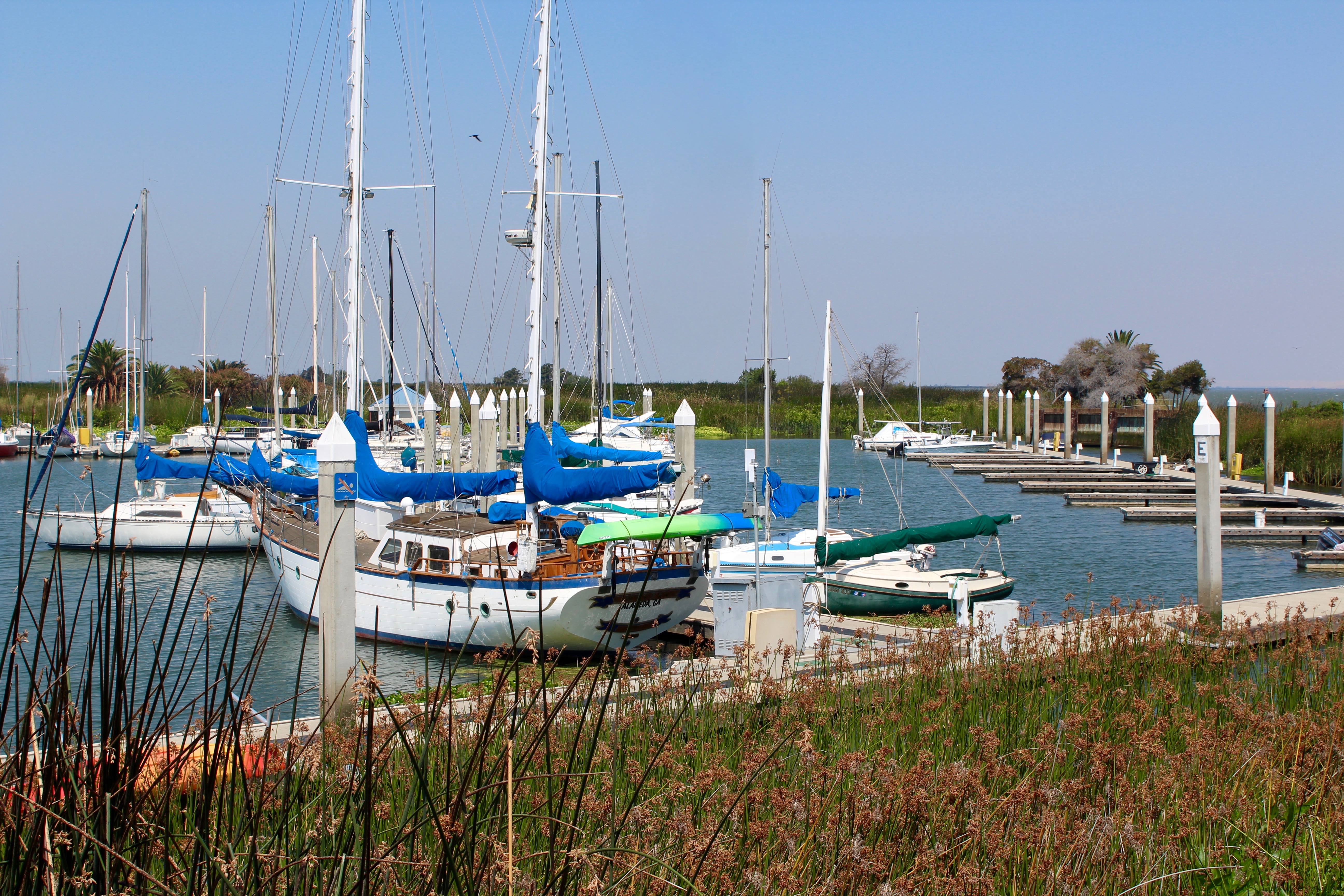
Special Recommendations. (1) This is a windy (sometimes very, very windy) area so always bring along warm clothing. (2) Remember to bring a freshwater fishing license. (3) Throw back most of your catch. The state recommends that you eat no more than four meals per month of any striped bass from this region because of elevated mercury levels in their flesh. And, women who are pregnant, nursing mothers, and children under 6 should eat no fish from the delta.
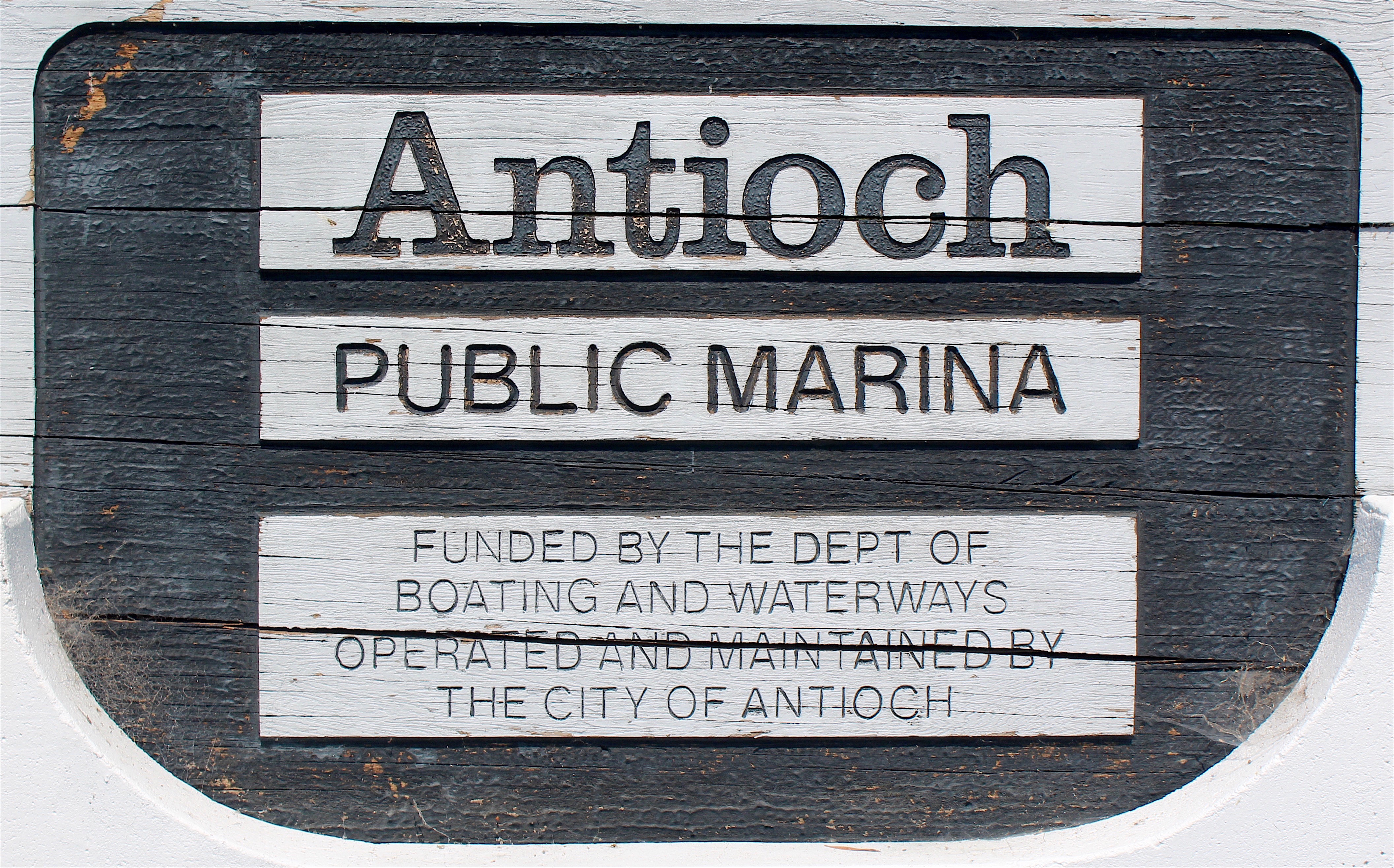
Antioch Marina Fishing Pier
Hours: Open 24 hours a day.
Facilities: The Antioch Marina has easy access and considerable free parking. Lights and a fish cleaning station exist, but no benches or windbreaks (and it gets windy so come prepared). Restrooms are located next to the marina but they are only open from 8-5. Although a bait and tackle store once was found in the marina it is gone. A bait and tackle shop (Lost Anchor 2 Bait and Tackle) is located a few blocks away at the corner of W 2nd St. and Prospects Way. To the left of the Smith’s Landing restaurant is a small park area with tables, benches, and BBQ facilities. Two line recycle bins are also found on the pier. Unfortunately the city gets an “A” for effort and a “F” for execution. There are no trash cans on the pier so what happens is that people stuff stuff — i.e., empty soda bottles in the line recycle bins and clog up the bins. How hard would it be to have a couple of trash cans on the pier?
Handicapped Facilities: Handicapped parking with restrooms marked handicapped accessible. The pier surface is wood with railings approximately 42 inches high.
Location: At the foot of L Street in Antioch (5 Marina Place)
How To Get There: From Highway 4, take the Contra Loma (L Street) exit and head north. Eventually it will end at the Antioch Public Marina and Marina Plaza Drive that takes you straight to the pier. The pier is to the right of the large Smith’s Landing Restaurant.
Management: City of Antioch.
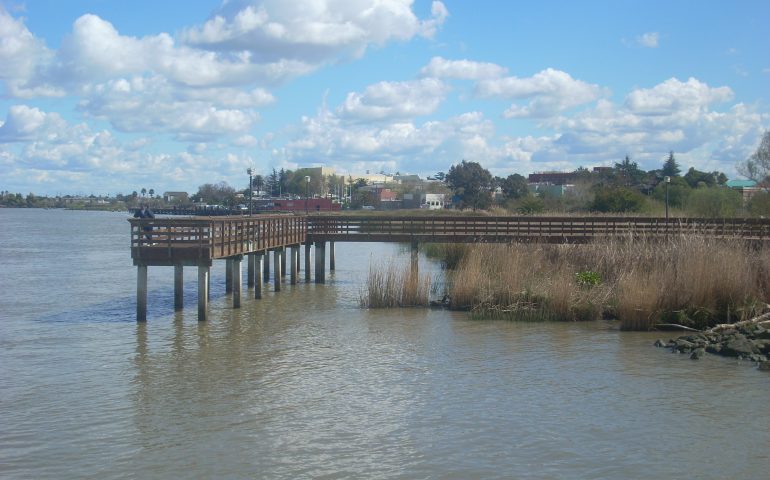
The dock at the end of smiths landing has a lock around
The gate so boaters and fisherman can’t access
That area. Is it possible to have it removed
So access can be obtained. And is it illegal
To have a chain and lock around for no access
The city manages the pier and dock and can pretty much do what it wants.